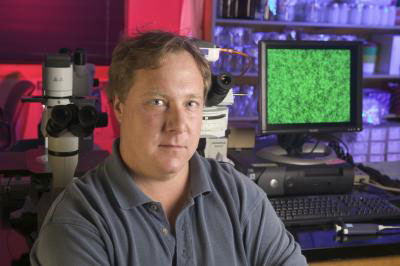Newly synthesized polymer, fitted with molecular pincers of carefully tailored structure, effectively captures nicotine molecules and its analogues. The polymer can be used for fabrication of sensitive and selective chemical sensors to determine nicotine in solutions, and in the near future also in gases. Moreover, the polymer is suitable for slow, controlled release of nicotine, e.g., for therapeutic purposes.
Aug 4th, 2011
Read more
Rice University lab shows troop how any carbon source can become valuable graphene.
Aug 4th, 2011
Read more
Dr. Kajornsak Faungnawakij, Head of Nanomaterials for Energy and Catalysis Lab at NANOTEC is one of 4 researchers chosen by the Foundation for the Promotion of Science and Technology under the Patronage of His Majesty the King to receive the 2011 Young Scientist Award.
Aug 4th, 2011
Read more
A single compound with dual function - the ability to deliver a diagnostic and therapeutic agent - may one day be used to enhance the diagnosis, imaging and treatment of brain tumors.
Aug 3rd, 2011
Read more
Researchers based at the Institute of Intelligent Machines, Chinese Academy of Sciences, are developing a plasma-assisted strategy for densely doping indium to give coral-like SnO2 nanostructures. Gas sensors based on the materials platform exhibit a high response and good selectivity to chlorobenzene.
Aug 3rd, 2011
Read more
A move toward smaller and smaller sample sizes is leading to a new generation of mass spectrometry instrumentation, reports Genetic Engineering and Biotechnology News (GEN).
Aug 3rd, 2011
Read more
 By coating gold nanoparticles with antibodies that bind to specific strains of the flu virus and then measuring how the particles scatter laser light, the technology can detect influenza in minutes at a cost of only a fraction of a penny per exam.
By coating gold nanoparticles with antibodies that bind to specific strains of the flu virus and then measuring how the particles scatter laser light, the technology can detect influenza in minutes at a cost of only a fraction of a penny per exam.
Aug 3rd, 2011
Read more
Cranfield's unique Nanomedicine MSc is the first course of its kind within the UK and Europe to bridge the gap between nanotechnology and medicine.
Aug 3rd, 2011
Read more
New 3-D-nanostructured chip offers a litmus test for surface tension (and doubles as a carrier for secret messages).
Aug 3rd, 2011
Read more
Mark Ming-Cheng Cheng, Ph.D., assistant professor of electrical and computer engineering at Wayne State University, recently received a five-year, $475,000 Faculty Early Career Development (CAREER) grant from the National Science Foundation to study the potential of graphene, a novel carbon material, in the development of a reliable, high-performance, long-term implantable electrode system to improve quality of life using nanotechnology.
Aug 3rd, 2011
Read more
Highly efficient organic light-emitting diodes are created by optimizing the molecular structure and device configuration.
Aug 3rd, 2011
Read more
 Researchers describe how tailored single strands of DNA can be used to purify the highly desired 'armchair' form of carbon nanotubes.
Researchers describe how tailored single strands of DNA can be used to purify the highly desired 'armchair' form of carbon nanotubes.
Aug 3rd, 2011
Read more
Gram for gram, novel carbon nanofiber-filled coatings devised by researchers from the National Institute of Standards and Technology and Texas A+M University outperformed conventional flame retardants used in the polyurethane foam of upholstered furniture and mattresses by at least 160 percent and perhaps by as much as 1,130 percent.
Aug 3rd, 2011
Read more
The FlexTech Alliance, focused on developing the electronic display and the flexible, printed electronics industry supply chains, today announced its 11th annual Flexible Electronics and Displays Conference and Exhibition will take place February 6-9, 2012 in Phoenix, Ariz.
Aug 3rd, 2011
Read more
NanoMatchGlobal is a structured, exclusive networking opportunity connecting leaders in nanotechnology.
Aug 2nd, 2011
Read more
Dr Xiao-Qi Zhou and colleagues at the University of Bristol's Centre for Quantum Photonics and the University of Queensland, Australia, have shown that controlled operations - ones that are implemented on the condition that a "control bit" is in the state 1 - can be dramatically simplified compared to the standard approach.
Aug 2nd, 2011
Read more



 Subscribe to our Nanotechnology News feed
Subscribe to our Nanotechnology News feed